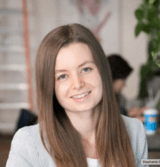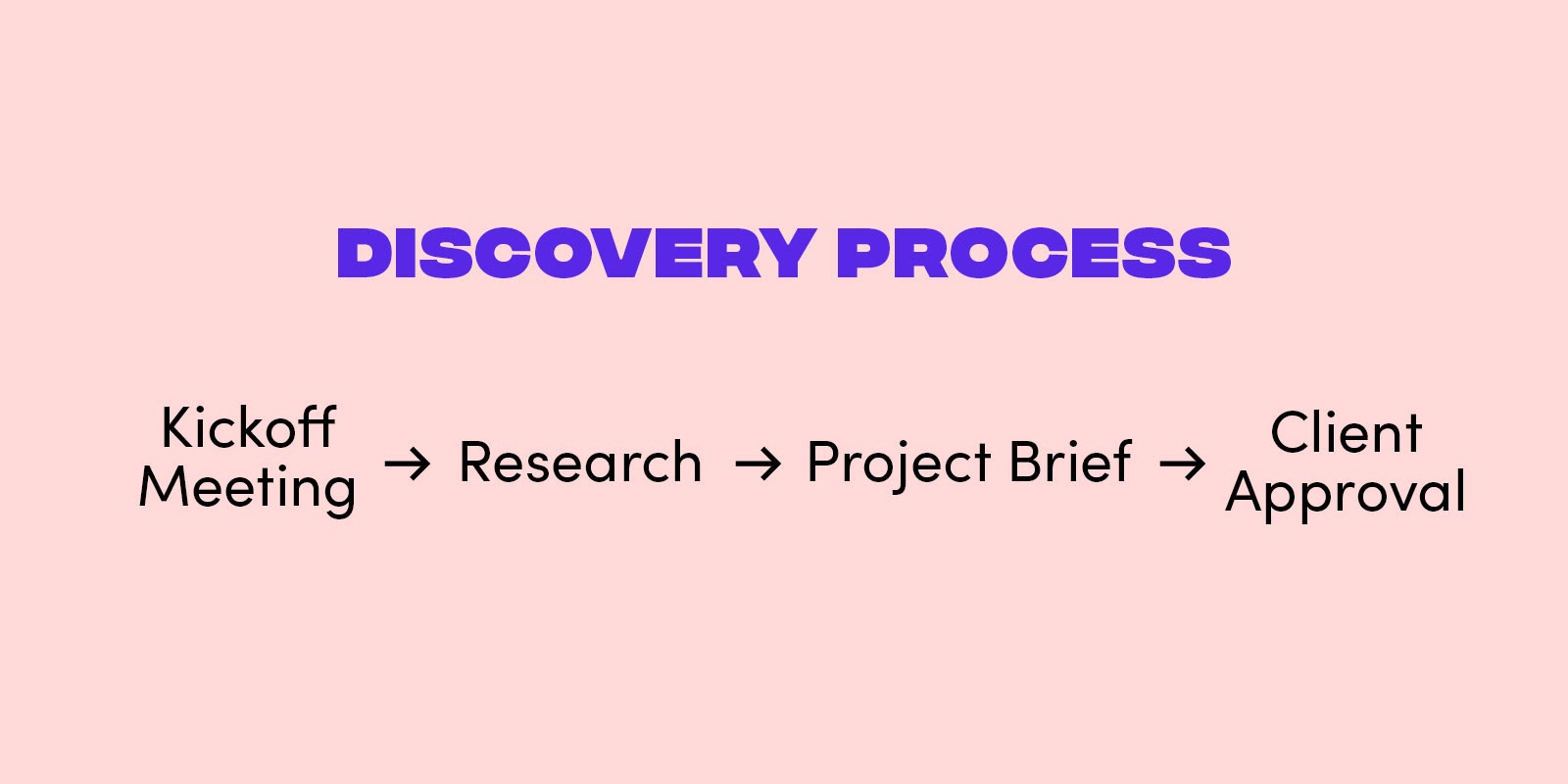No items found.
Get our weekly updates, including high-value tips and free resources that will help you take your design career to the next level.


Have you ever been stuck in a frustrating revision cycle with no end in sight? Have you created work that met all of your client's requirements, only for them to change their mind and ask for something completely different? Do you ever feel like you're playing a dangerous guessing game when deciding which creative direction to take?
If you're nodding your head to any of these questions, chances are that your discovery process has some room for improvement. A clear, thoughtful, and strategic project discovery phase can nip all of these problems and more in the bud. Keep reading to explore why the discovery phase is so important and what you can do to improve your process right away.
Many designers and creatives have a process for their work that's unique to them. Everyone's different, and a method that one designer swears by could feel sticky to another designer with a different working style. That said, most successful creative projects follow the same fundamental process, which includes four essential phases: Discovery, Execution, Refinement, and Delivery.

The second, third, and fourth phases of this process are fairly self-explanatory; we all know how to execute our craft, make refinements based on feedback, and deliver the final product. The phase that most creative professionals get stuck on is the discovery phase. In fact, you can often distinguish a new designer from an experienced designer based solely on their process. Experienced creatives tend to have a smooth and clear process that they refined over time, whereas beginners often trip up on project discovery, or in some cases, skip over it entirely.
The worst thing you can do for your creative projects is to neglect the discovery phase. Without this essential step, you'll likely get caught in an endless cycle of revisions and create a poor client experience built on a lack of communication and trust. A weak discovery process can similarly cause issues. Fortunately, you're in the right place to learn how to improve your process and create better, more meaningful results for your clients.
If the thought of conducting a project discovery phase with your clients sounds intimidating, don't worry. We're going to break it down step by step so that you can start implementing this important process right away. As mentioned above, every creative has a unique process and every project has different requirements. We'll give you a framework to start with, but over time, you should adapt your process to your industry, niche, and preferences. The only way to develop a seamless process that works for you and the majority of your clients is through practice.
In a nutshell, the discovery phase helps you and your client understand what goals you're working towards, and what steps you'll take to achieve them. The first part of this is all about gathering information. This is probably where the term "discovery" comes from; in essence, you're discovering everything you need to know about the client's business in order to achieve a specified outcome through your work.
After you've gathered information, both directly from the client and from your own research, your next job is to condense all that info into a project brief. This brief provides clarity for both you and your client on what's happening, when, and why. It literally gets you on the same page so that you can then start the implementation phase feeling confident in what you need to do. It also sets expectations for the client so that they can see how your work relates to their overarching goals.
Check out Ran Segall’s video below for an example of the discovery process for branding clients:
If you can't already tell, we believe very strongly in the power of a strategic discovery phase. Especially if you're working on a branding or web design project, which have enormous ROI potential for businesses, an effective discovery process can have a huge impact on your client. It also positions you as a confident and trustworthy expert who has your client's best interests in mind. The better your process, the more likely your clients will bring more business your way through referrals or additional projects.
Here are a few key benefits of the project discovery phase:
Understanding the benefits of project discovery also helps you sell your services to clients in the first place. Clients want to work with creatives who are in their corner, not just working for the money and portfolio piece. A great way to gain the trust of prospective clients is to tell them about your process, especially the discovery phase.
Now that we understand what the discovery phase is for and why it's important, let's dive deeper into what the process actually looks like. In this section, we're going to break it down into four steps. Keep in mind that depending on context, you may need to add or revise steps in order to develop a discovery process that works best for you and your clients.

The very first step in any discovery process is typically a kickoff meeting. If you're working one-on-one with a client, this meeting is just between you and your client. If you're working with a medium-to-large sized business, there may be multiple decision makers on the client's end who'll attend this meeting.
A kickoff meeting could be conducted virtually or, if possible, in person. If it's a virtual meeting, we recommend doing a video call to help build that trust and rapport.
It's crucial to come prepared to your kickoff meeting in order to start the project on the right foot. Typically, you'll be the one spearheading this meeting, not your clients. However, your clients should do most of the talking. Your role in this meeting is to ask thoughtful questions, listen attentively, and probe deeper when necessary.
Kickoff meeting vs. questionnaire
You may be wondering: Couldn't I just send the client a questionnaire to gather information from them? You could, but we don't recommend it. Here's why:
Questionnaires can be useful in the right context. If you're going to use them in your process, we recommend still scheduling a live kickoff meeting to talk through your client's answers in more depth.
After you've conducted the kickoff meeting with your client, you should have a better understanding of your client's business and how you can support them in reaching their goals. With this information in hand, you can now embark on your own research on their industry, competitors, target market, etc.
How deep you want to go with your research is up to you. At minimum, you should look up your client's competitors and learn what you can about their target market. This is especially true for branding and web design projects. There's a good chance that your clients need help differentiating themselves in their industry and attracting their target audience. Your design work can help them on both of these fronts.
The majority of your research can be done with a few Google searches; however, if you want to take this process to the next level and really impress your clients, you could conduct live interviews with individuals within your client's target audience. Your main goal is to learn what their pain points are in relation to your client's offers. This allows you to develop messaging and visuals that directly address their problems.
After you've collected information from the kickoff meeting and your own research, your next step is to assemble what you've learned into a project brief. A project brief is a short document (1-2 pages) that summarizes the plan for the project. This document is crucial for getting everyone involved in the project on the same page prior to starting the execution phase.
Here are some suggestions for what to include in your project briefs:
Although these suggestions are a great starting point, you should adjust your project briefs according to context. For instance, if there are multiple people involved in the project, be sure to outline who's responsible for what. You may also wish to include some creative direction with your brief, for instance a mood board. Experiment and discover what works best for you to create alignment at this early stage of the project.
Check out this post to learn more about creating design project briefs.
The final step in our project discovery process is securing the client's approval. Ideally, you'll present your project brief to the client in a live meeting so that you can field their questions. It's important that the client reviews the brief thoroughly and approves every point. You may also wish to secure written approval in case the client tries to steer the project off course later on.
One or two rounds of refinement are sometimes necessary in order to gain approval on the project brief. This is totally normal and expected. The more confident your client feels in the project upfront, the more likely that the rest of the process will flow smoothly.
Once your project brief is approved, the discovery phase is complete and you're ready to move into implementation, aka the fun part!
If you want to learn more about how to create a strategic and streamlined web design process that produces real results for your clients, we invite you to check out our course The $10k Website Process. As the name suggests, this course delivers a step-by-step framework for creating valuable websites that demand high prices.
Click here to learn more about the course content and all the expert-level support you'll receive along the way.
Get our weekly updates, including high-value tips and free resources that will help you take your design career to the next level.



